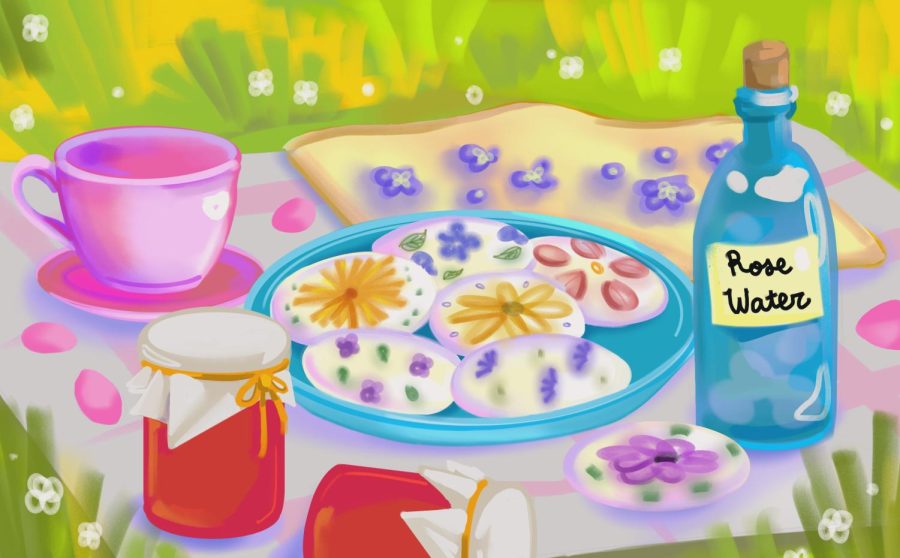Dahlia-tful and unbe-lily-vable flower recipes that will grow on you
FLOWER POWER: A picnic amidst the spring blooms is the perfect opportunity to showcase your natural creations.
March 11, 2023
Now that the weather’s getting warmer, you may notice colorful flower buds decorating bushes and trees on your way to school. Other than just being a part of a pretty bouquet, flowers provide nutrients such as vitamin A, C, riboflavins, niacin, minerals, calcium, phosphorus and other minerals.
Keep in mind that it is important to be safe while experimenting with flowers. Make sure to properly identify all plants with a guide or plant-scanning app, such as PlantSnap, before consuming.
1. Homemade Tea
There are numerous floral teas—jasmine, rose, lavender and chamomile—that are aromatic and have medicinal benefits. It’s easy to dry your own flowers, as long as they’re pesticide free.
The most affordable way to dry flowers is by air drying. First, place blooms on a flat, dry surface with plenty of airflow. Then, let them dry at room temperature until crisp. Measure out about two to three teaspoons of flowers for every cup of boiling water. Steep the petals for three to five minutes.
2. Edible Flower Cookies
Flowers can be used to elevate the presentation of foods, as seen in sugar cookies with flowers pressed into the surface. Some of the prettiest edible flowers include roses, pansies, dahlias, lily, lavender and violas. It is best to use sugar cookie dough and chill for at least 30 minutes before use. With a cookie cutter to shape the dough, brush egg whites onto the surface for better adhesion and sprinkle a pinch of sugar on top of the flower to add some sweetness. When baking, check on the cookies often to ensure that the flowers don’t burn.
3. Fabric Dye
Woad leaves create a beautiful deep blue dye, marigolds create a warm yellow and hollyhock makes a beautiful rust and red hue.
Put flowers in a pot and add just enough water to cover them. Simmer at 160 degrees Fahrenheit for 30 to 45 minutes. Strain the liquid to separate the flowers and the liquid, then reheat the flowers in water until they stop secreting dye. The resulting liquid can be used to alter the color of fabrics.
4. Flower Jelly
To make flower jelly, add two tablespoons of lemon juice to four cups of floral tea. Boil the mixture and add a packet of pectin. After boiling for a minute, add four cups of sugar and mix. After simmering for a minute, pour into mason jars and let cool.
Likely found in your own backyard, clovers have a sweet, anise-like flavor and have been used against gout, rheumatism and leucorrhea. Dandelions have a sweet, honey-like flavor when picked young. The buds of the flower impart the most flavor for a unique and sweet jelly.
5. Skincare: Rosewater
Last but not least, it’s simple to make rosewater with inflammatory properties for skincare. Simmer dried or fresh rose petals in water until infused. Once strained, rosewater can be dabbed onto clean skin to restore pH balance, clean off oils and hydrate skin. Rosewater also lowers skin irritation, contains healthy antioxidants and heals minor wounds.


























































